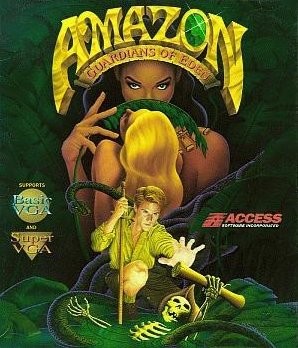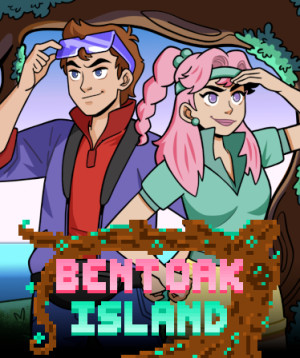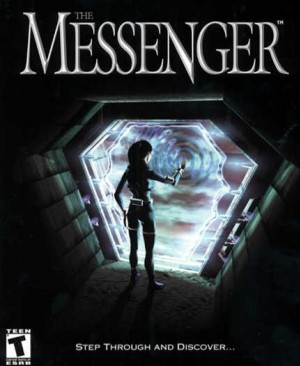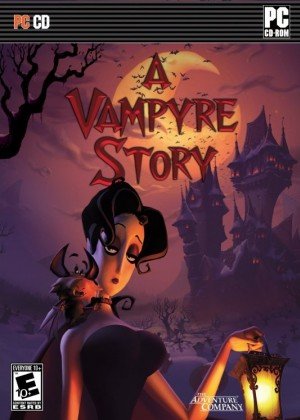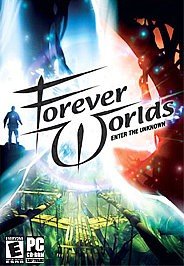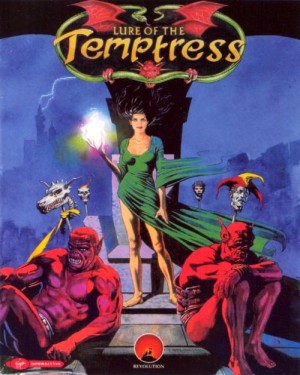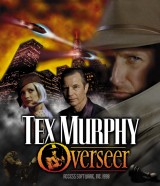Review for Amazon: Guardians of Eden

For longtime adventure fans, Access Software is pretty much synonymous with Tex Murphy, or more specifically, the final three games in that venerable series. The first two adventures for the hard-boiled PI are often overlooked, as they’re presented in third-person perspective and follow a very linear game structure, rather than the fully 3D first-person view and more complex narratives that popularized the series later on. Almost entirely forgotten today is that after Martian Memorandum, Chris Jones wrote and designed a non-Tex Murphy adventure, Amazon: Guardians of Eden. The game is still worthy of attention, however, at least for its historical value, as it’s clear in hindsight that this adventure is both a fundamental milestone in Access Software’s development history and, most importantly, the dress rehearsal for the masterpiece Under a Killing Moon.
But enough of the history lecture and let’s get to the game itself. Amazon puts the player in the role of Jason Roberts, a young and inexperienced employee of Allister Research, a company for which his older brother Allen also works. On a bright morning, Jason arrives at this office in Oregon, and he’s about to start another boring day when he discovers that Allen’s team has been attacked by unknown foes during an expedition in the Amazon River basin. While the other members of the crew have all been murdered, Allen himself is simply missing. The world is at the apex of the Cold War and Allister Research has strict rules about secrecy, for fear of the Communists stealing the hard-earned fruits of American technology, so Jason is left with no clue about what his brother was doing in Amazonia. When Jason finds an unopened package from Allen, it soon becomes clear that he and his team were on the verge of a capital discovery, and Allen now fears for his very life.
And so begins the player’s adventure, as an encrypted message leads Jason back to Allister Research to recover some vital documents for his brother, and then straight onto an airplane toward a small settlement on the bank of Rio Blanco. During his journey along the impetuous river, Jason will have to face bandits, corrupt policemen, cannibals and slave traders, all of them determined to prevent him from reuniting with his brother. Luckily for him, he isn’t entirely alone because in the most hopeless hour he meets Maya, a stunningly beautiful, tight-dressed mysterious woman who helps him in a desperate race against time to find the lost treasure of the Conquistadores.
If this plot seems a bit like a déjà vu, it’s because it really is clichéd. Throw into a cauldron some Indiana Jones and the old Charlton Heston movie Secret of the Incas, add the romantic comedy of Romancing the Stone with a pinch of Cold War political farce, and you have the exact recipe of Amazon. The surprise is that it’s an incredibly tasty dish: the ingredients blend strikingly well and the witty, satirical writing by Jones is the perfect icing on the cake. The situations and the characters are so exaggerated that it’s impossible to not laugh out loud at the salacious barbs against the evil Communist spies, the sharp wisecracks about American paranoia during the Cold War or the constant irreverent bickering between Jason and Maya, who form a perfect screwball comedy pair. The self-mocking script is so entertaining that it will enthral players until the very (and very kitsch) ending, amusing us with all kind of (mis)adventures: kidnapping, plane crashes, chases through the jungle, bloody gunfights, explosions and so on. Playing through Amazon is like reading a good novel by Emilio Salgari or watching one of those adventurous TV shows from the ’60s, like Hanna-Barbera’s Danger Island. Even the transition between chapters resembles the advertisements of those old series, with their bold banner headline – “Don’t miss our next intriguing chapter!”. The pulp titles really deserve an ovation for their shamelessness: “Heavy Metal Monster”, “Flight of Doom” and “Bridge of Death” are only a few examples of the episodes into which Amazon is divided.
Access Software promoted the game in 1992 as an interactive cinema adventure, made even more spectacular by the Super VGA graphics. As the back of the box states, this technology allows the player to display not only the main action screen and inventory, but nothing less than sixteen icons which grant the ability to review the already-played chapters through an animated summary. Unfortunately, I wasn’t able to play Amazon in this mode, since the Super VGA setting seems incompatible with modern graphics cards. I had to settle for the standard VGA mode, which is far from the promised photographic quality. The locations are indeed colorful and bright, but they are also grainy and unpolished, often murky and poorly detailed. The age of the game is not an excuse, since two years before Amazon, Sierra’s King’s Quest V showed what really could be done with VGA, and Amazon fails to reach even that older graphical standard.
The visual quality slightly improves in the close-up screens, in which the level of detail gets better and the overall impression becomes more defined and accurate. The same can be said for the character portraits during dialogues, which are a huge step forward from the first two Tex Murphy games. Unfortunately, the quality of the acting has not similarly improved. Although voice work is sparsely used, usually only for the first lines of each dialogue, the acting is somewhere between lousy and dreadful, thanks to the ridiculous facial expressions displayed by the actors, whose voices are even worse.
This leads to another much-debated issue, the (in)famous Real Sound, a technology built by Access Software itself. The game promises a “lifelike realism you could only dream of before” but, sadly, the result is quite the opposite. When you finally manage to get the sound to work – and that’s anything but an easy job – prepare yourself for a bad surprise. The vocal quality, although better than that heard in Martian Memorandum, still screeches and the sound effects have an unpleasant metallic tonality that constantly distorts them. On the other hand, the orchestrated music is quite good and varied, from the parade march-like theme at Allister Research to the drums, horns and flutes heard in the deepest parts of the jungle. Nothing is incredibly stunning, but the music serves the story just fine and provides a nice overall background during the game.
Like the earlier Access games, Amazon runs mainly from a third-person perspective, with the keyboard used to move the character around the screen and the mouse to interact with the environment. When entering some important locations, the perspective changes to a first-person point of view, but in both cases all the actions – Look, Move, Pick Up, Climb – are performed through an icon-driven interface that replaces the verb-based one seen in the first two Tex Murphy titles. Unfortunately, this interface has its share of problems: the keyboard movement is clunky and imprecise, making it difficult to correctly place the character, resulting in several “Move closer” or “You’re not close enough” messages. Moreover, when the player picks up an item from the inventory and uses it on the screen, the cursor retains the object’s shape whether the object was correctly used or not. This little annoyance sometimes makes it hard to determine if a certain action has succeeded.
The most annoying flaw of the interface, however, is the way it deals with dying and restoring. Amazon has several ways to die, and each time Jason fails a sequence of actions the game prompts the player with a death screen. Thankfully this contains some clues on how things need to be done, but the game then restarts from the very beginning. It’s only then, after the animated introduction, that the player can load a previous save. In a particularly tricky timed sequence, I died almost twenty times and, after the tenth restart, I began to hate the allegro opening theme and I had to turn the music down.
Did I mention timed sequences? While hardly an uncommon feature at the time of release, Amazon totally raises the bar in this regard, since more than 70% of the game consists of timed actions that sometimes give the player only a short time to figure out the right thing to do. While many solutions are puzzle-based, on at least one occasion fast reflexes and good hand-eye coordination are required. But just when you think that the bad part is over, there is also a stealth segment where, in a very confined space, Jason has to perform a linear sequence of actions while avoiding a patrolling guard. It goes without saying that the uncomfortable interface makes these sequences even more frustrating. Worse, there are three arcade sequences involving canoe-riding that, whilst quite easy to master, quickly become annoying and serve no other purpose than to artificially lengthen the game.
Actual deaths, and there are plenty of them, aren’t the only problem, since the game is equally unforgiving in other ways. An unattentive player can reach multiple dead ends, not only by overlooking important objects but even by failing to carefully examine all the well-hidden hotspots, thus forcing a thorough pixel hunt in every location. Having played many Sierra games, I’m used to these kinds of obstacles, so I saved early in the game and often throughout it, but for some players, especially the ones not used to such old-school adventures, this will be a major flaw and a serious detriment to their gaming experience.
It’s a shame that the gameplay is so muddled, because the actual puzzles are great. They are mostly inventory-based but although never groundbreaking, they are clever and prove to be a real challenge even for the seasoned adventurer. They never become frustrating, though, because the developers built an in-game hint system that can be used to receive clues about objects and hotspots. It’s mostly in this regard that Amazon feels like a warm-up for Under a Killing Moon. As in that game, if a player continuously uses this feature in Amazon, the overall score of the game is lowered, resulting in a different, less satisfying finale. There is no reason to worry, though, as it’s unlikely that anyone will need the hints more than three or four times during the whole game, because the puzzles are always logical and well-integrated in the gameplay.
Dialogue puzzles also make an appearance in Amazon. Not as developed as they become in the following Tex Murphy games, here they are never difficult nor require much thought from the player, since it’s always pretty obvious which answer is the right one. Nonetheless, they are a nice addition and incredibly funny: Jason can be a real buffoon and his lines are often stuffed with all kind of jokes and puns, so I tried even the most politically incorrect answers just for the fun of it. Late in the game there are also a couple of puzzles where the player has to switch between Jason and Maya in order to progress. Amazon uses these scenarios cleverly, with lots of interaction between the two characters and an over-the-top humor that makes them a real pleasure to play.
Rating Amazon: Guardians of Eden is a tough job: the game is a solid, old-fashioned aventure with clever puzzle design, an engrossing B-movie story and very likeable characters. The overall experience, however, is harmed by serious problems in terms of gameplay and interface, not to mention production values that have aged horribly, at least in the absence of SVGA compatibility. The final score must account for all these flaws, and yet this is a game that I can’t help but recommend to old-school adventurers. Not only does Amazon represent a fundamental passage from earlier Access Software titles to the more mature games heralded by Under a Killing Moon, it has much to offer as an adventure in its own right. It may be dated and may be flawed, but it’s undeniably entertaining.
Our Verdict:
Despite its unpolished gameplay and dated (even at the time) production values, Amazon is still an engrossing game that will please many old-school adventurers.


